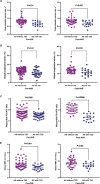Association Between Type 2 Diabetes and Changes in Myocardial Structure, Contractile Function, Energetics, and Blood Flow Before and After Aortic Valve Replacement in Patients With Severe Aortic Stenosis
- PMID: 37746744
- PMCID: PMC10558154
- DOI: 10.1161/CIRCULATIONAHA.122.063444
Association Between Type 2 Diabetes and Changes in Myocardial Structure, Contractile Function, Energetics, and Blood Flow Before and After Aortic Valve Replacement in Patients With Severe Aortic Stenosis
Abstract
Background: Type 2 diabetes (T2D) is associated with an increased risk of left ventricular dysfunction after aortic valve replacement (AVR) in patients with severe aortic stenosis (AS). Persistent impairments in myocardial energetics and myocardial blood flow (MBF) may underpin this observation. Using phosphorus magnetic resonance spectroscopy and cardiovascular magnetic resonance, this study tested the hypothesis that patients with severe AS and T2D (AS-T2D) would have impaired myocardial energetics as reflected by the phosphocreatine to ATP ratio (PCr/ATP) and vasodilator stress MBF compared with patients with AS without T2D (AS-noT2D), and that these differences would persist after AVR.
Methods: Ninety-five patients with severe AS without coronary artery disease awaiting AVR (30 AS-T2D and 65 AS-noT2D) were recruited (mean, 71 years of age [95% CI, 69, 73]; 34 [37%] women). Thirty demographically matched healthy volunteers (HVs) and 30 patients with T2D without AS (T2D controls) were controls. One month before and 6 months after AVR, cardiac PCr/ATP, adenosine stress MBF, global longitudinal strain, NT-proBNP (N-terminal pro-B-type natriuretic peptide), and 6-minute walk distance were assessed in patients with AS. T2D controls underwent identical assessments at baseline and 6-month follow-up. HVs were assessed once and did not undergo 6-minute walk testing.
Results: Compared with HVs, patients with AS (AS-T2D and AS-noT2D combined) showed impairment in PCr/ATP (mean [95% CI]; HVs, 2.15 [1.89, 2.34]; AS, 1.66 [1.56, 1.75]; P<0.0001) and vasodilator stress MBF (HVs, 2.11 mL min g [1.89, 2.34]; AS, 1.54 mL min g [1.41, 1.66]; P<0.0001) before AVR. Before AVR, within the AS group, patients with AS-T2D had worse PCr/ATP (AS-noT2D, 1.74 [1.62, 1.86]; AS-T2D, 1.44 [1.32, 1.56]; P=0.002) and vasodilator stress MBF (AS-noT2D, 1.67 mL min g [1.5, 1.84]; AS-T2D, 1.25 mL min g [1.22, 1.38]; P=0.001) compared with patients with AS-noT2D. Before AVR, patients with AS-T2D also had worse PCr/ATP (AS-T2D, 1.44 [1.30, 1.60]; T2D controls, 1.66 [1.56, 1.75]; P=0.04) and vasodilator stress MBF (AS-T2D, 1.25 mL min g [1.10, 1.41]; T2D controls, 1.54 mL min g [1.41, 1.66]; P=0.001) compared with T2D controls at baseline. After AVR, PCr/ATP normalized in patients with AS-noT2D, whereas patients with AS-T2D showed no improvements (AS-noT2D, 2.11 [1.79, 2.43]; AS-T2D, 1.30 [1.07, 1.53]; P=0.0006). Vasodilator stress MBF improved in both AS groups after AVR, but this remained lower in patients with AS-T2D (AS-noT2D, 1.80 mL min g [1.59, 2.0]; AS-T2D, 1.48 mL min g [1.29, 1.66]; P=0.03). There were no longer differences in PCr/ATP (AS-T2D, 1.44 [1.30, 1.60]; T2D controls, 1.51 [1.34, 1.53]; P=0.12) or vasodilator stress MBF (AS-T2D, 1.48 mL min g [1.29, 1.66]; T2D controls, 1.60 mL min g [1.34, 1.86]; P=0.82) between patients with AS-T2D after AVR and T2D controls at follow-up. Whereas global longitudinal strain, 6-minute walk distance, and NT-proBNP all improved after AVR in patients with AS-noT2D, no improvement in these assessments was observed in patients with AS-T2D.
Conclusions: Among patients with severe AS, those with T2D demonstrate persistent abnormalities in myocardial PCr/ATP, vasodilator stress MBF, and cardiac contractile function after AVR; AVR effectively normalizes myocardial PCr/ATP, vasodilator stress MBF, and cardiac contractile function in patients without T2D.
Keywords: aortic valve stenosis; diabetes mellitus, type 2; magnetic resonance imaging; myocardial blood flow.
Conflict of interest statement
Figures



References
-
- Makkar RR, Thourani VH, Mack MJ, Kodali SK, Kapadia S, Webb JG, Yoon S-H, Trento A, Svensson LG, Herrmann HC, et al. ; PARTNER 2 Investigators. Five-year outcomes of transcatheter or surgical aortic-valve replacement. N Engl J Med. 2020;382:799–809. doi: 10.1056/NEJMoa1910555 - PubMed
-
- López-de-Andrés A, Perez-Farinos NA-O, de Miguel-Díez J, Hernández-Barrera V, Méndez-Bailón M, de Miguel-Yanes JM, Jiménez-García R. Impact of type 2 diabetes mellitus in the utilization and in-hospital outcomes of surgical aortic valve replacement in Spain (2001-2015). Cardiovasc Diabetol. 2018;17:135. doi: 10.1186/s12933-018-0780-2 - PMC - PubMed
-
- Halkos ME, Kilgo P, Lattouf OM, Puskas JD, Cooper WA, Guyton RA, Thourani VH. The effect of diabetes mellitus on in-hospital and long-term outcomes after heart valve operations. Ann Thorac Surg. 2010;90:124–130. doi: 10.1016/j.athoracsur.2010.03.111 - PubMed
Publication types
MeSH terms
Substances
Grants and funding
LinkOut - more resources
Full Text Sources
Other Literature Sources
Medical
Research Materials

